NB-IoT: how does it work? Part 1
Devices in the standard NB-IoT can work up to 10 years from one ordinary battery. Due to what? We have collected all the most important things about this technology. In this article, we will talk about its features from the point of view of the radio access network architecture, and in the second part, about changes in the network core that occur during NB-IoT.
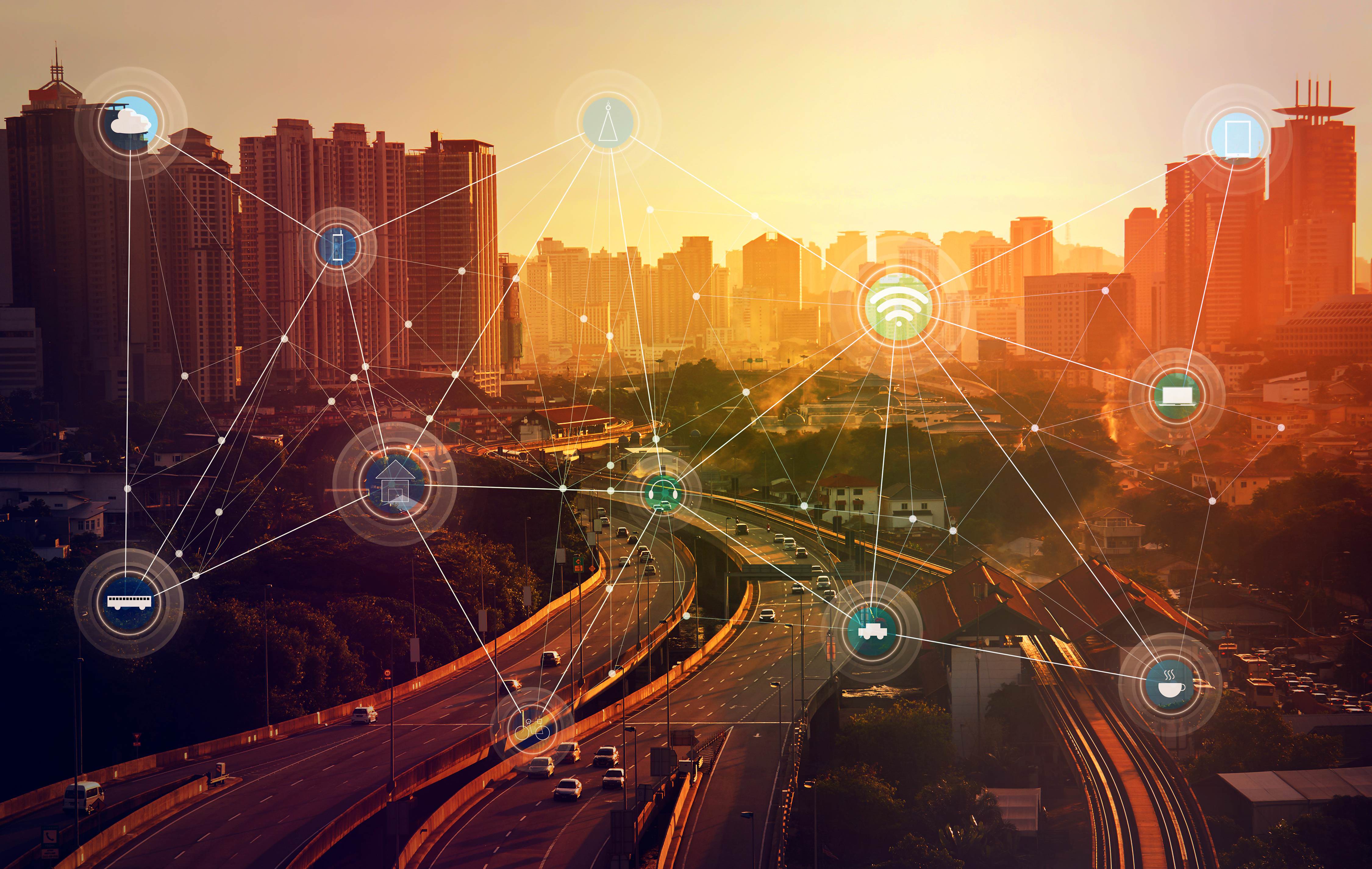
NB-IoT technology has inherited a lot from LTE - from the physical structure of the radio signal to the architecture. Everything cannot be listed in one article, so we will try to focus on the main features for the sake of which this technology was created. So:
')
What is the difference between NB-IoT in terms of the radio access network architecture?
First, remember the important thing about LTE:
For the LTE signal, the principle of separation of OFDM channels with a subcarrier spacing of 15 kHz is used. In DL (Downlink, direction from BS), OFDMA is used, and in UL (Uplink, direction to BS), SC-FDMA is used. The whole carrier in LTE is divided into resource blocks (Resource block, RB), each of which consists of 12 subcarriers and a total occupied bandwidth of 12x15 kHz = 180 kHz (Fig. 1). Each resource block is divided into 12x7 = 84 resource elements (Resource element, RE).
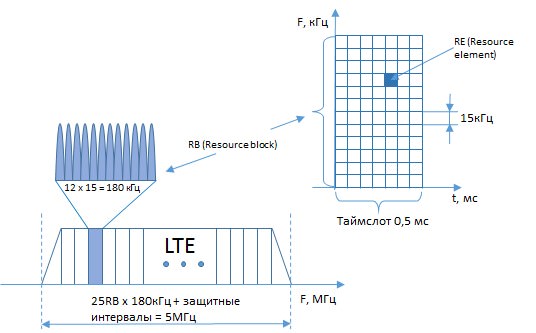
Fig.1. Resource block, Resource element
To achieve high cell throughput, high modulation orders of QAM256 are used for DL and QAM64 in UL. In addition, MIMO2x2 and MIMO4x4 technologies will be used for the same purpose.
Features of the radio signal NB-IoT :
The most important thing in the NB-IoT is the ability to work at lower signal levels and at high noise levels, as well as saving battery power. NB-IoT is also designed to transmit short messages, and it is not required to transfer audio-video content, large files and other things from it.
On this basis, on the physical level there are certain features that help provide the necessary characteristics:
Below we will focus on some of them in more detail.
The use of a narrow band of frequencies in one RB, one antenna and half-duplex transmission mode allows you to simplify the device and achieve:
Radio frequency assignment:
For the NB-IoT, almost all the same frequency bands as the 2G / 3G / 4G in the “low” band can be used. These are B20 (800 MHz), B8 (900 MHz), B3 (1800 MHz). There is no sense to use “higher” frequencies because of the greater attenuation of the signal.
There are three ways to allocate frequency resource for NB-IoT:
1. Stand-alone.
Dedicated frequency channel width of 200 kHz. This option is the most effective for the work of NB-IoT, but also the most costly. The fact is that in this case it may be necessary from 300 to 600 kHz of a very valuable spectrum, together with guard intervals. In this case, mutual interference with other technologies is minimal (Fig. 2).

Fig. 2. Options for placing NB-IoT in stand-alone mode.
2. In-band
In this case, resources are allocated for the NB-IoT within the existing LTE carrier, but the NB-IoT carrier has an increased power of 6 dB compared to LTE resource blocks. This option is well suited for saving frequency resource, but there is a problem of mutual influence with the LTE network (Fig. 3).
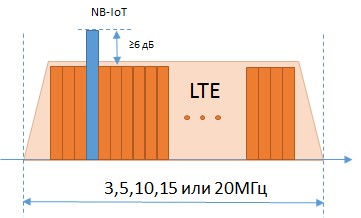
Fig. 3. Placing the NB-IoT in in-band mode.
3. Guard Band
In this case, the NB-IoT starts in the so-called guard interval. For example, in the LTE10MHz band, 500 kHz of free spectrum used as a guard interval. As in the in-band mode for longer range, the NB-IoT carrier has an increased power of 6-9 dB as compared to LTE resource blocks (Fig.4). This use case allows you to simultaneously save frequency resource and reduce mutual influence with the LTE network, although in this case, out-of-band emission parameters for LTE deteriorate.

Fig. 4. Placing the NB-IoT in guard-band mode.
The ability to transmit in the direction of UL on one subcarrier:
If in LTE, blocks of resource groups consisting of one or several RBs are allocated to a subscriber, then in NB-IoT the minimum unit is RE - portions of a radio resource are cut to the subscriber. Therefore, it became possible for the device to transmit a signal in UL on one subcarrier at 15 kHz. At the same time, now for the NB-IoT, the division of the RB into 48 subcarriers at 3.75 kHz in the UL direction has already been standardized. The duration of the resource elements at the same time is quadrupled, and, accordingly, the timeslot up to 2 ms, so their information capacity does not change (Fig. 5).

Fig.5. Resource element.
Signal transmission in a narrow band on one subcarrier of 15 kHz, and even more so at 3.75 kHz, can significantly increase the spectral density of the signal and, accordingly, the signal-to-noise ratio, which is very important for subscriber devices that have much less powerful transmitters than the base station. Moreover, in NB-IoT, as well as in LTE, the power of subscriber devices is limited to 23 dBm (200 mW).
At the same time, if the radio conditions allow, to reduce the time of the active transmission mode, and accordingly save the battery, it is possible to transmit on several subcarriers simultaneously. Transmission on one subcarrier has the name of the single-tone transmission mode, and on several - multi-tone (this is 3, 6 or 12 subcarriers at 15 kHz). Figure 6 shows the formation of different variations of the resource unit from the resource elements (Resource unit, RU).

Fig.6. Resource units (RU).
RU is the next larger brick from which transport blocks (Transport block, TB) are formed, which are assigned to the user. In one TB can be from one to ten RU. However, depending on the quality of the signal, each TB may contain a different amount of useful information depending on the modulation coding scheme (MCS) used. The TB size in the NB-IoT is, of course, much smaller than in LTE and is 680 bits in DL and 1000 bits in UL (Rel.13 3GPP). Also in this standard there is only one HARQ process (Hybrid Automatic Repeat Request), so the next TB can only be transmitted after acknowledging the reception of the previous TB. In release 14 of 3GPP, transport block sizes are increased to 2536 bits and Dual-HARQ, which allows two transport blocks to be transmitted in a row.
Coverage enhancement:
Another feature of NB-IoT is the coverage enhancement functionality, which is achieved by successive repetitions of the transmitted signal. This mechanism should not be confused with the re-transmission of a packet in case of unsuccessful reception; in the case of coverage enhancement, the decision on the success of the received signal occurs after receiving all repeated messages (Fig. 7). All physical channels NPDCCH, NPDSCH, NPRACH and NPUSCH (here N is the Narrowband prefix) can repeat.

Fig. 7. Repeats in NB-IoT
The standard defines three stages, called the coverage level 0, 1 and 2. The number of repetitions can vary widely and is set individually for each type of physical channel and its format. For example, the standard specifies values for a useful signal in UL up to 128 and in DL up to 2048. In reality, of course, everything will depend on the network settings optimized for operation (stand-alone, in-band / guard-band), signal quality and other conditions. Repeaters allow you to decode a signal at a much lower level of the signal-to-noise ratio theoretically up to 10 dB and below.
All of the above - the use of a narrower bandwidth and coverage enhancement function - allows you to eventually achieve the notorious gain of 20 dB relative to GSM.
Transmission rates in NB-IoT
In general, the principle of IoT itself, as already mentioned above, does not imply a significant exchange of information with devices, and accordingly, these values are very conditional. First, they are achieved only with good signal quality. Secondly, the signaling exchange, including the designation of the DCI kahal and the acknowledgment of ACK reception, is not adapted, as in LTE, to obtain maximum speeds. Thirdly, if the device transmits only one or two short messages, then in this case it is not entirely unambiguous what is meant by transmission speed. But not to say about the speed here is impossible. For example, Fig. 8 shows the calculated speed in DL for the user.
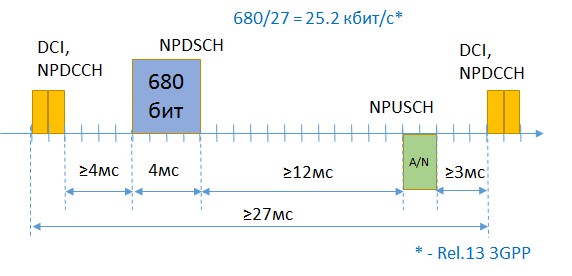
Fig.8. DL Transmission Rate
The figure shows that in NB-IoT, unlike LTE, the user device cannot occupy the entire available radio resource. And the rest of the BS radio resource can be used to communicate with other devices. The situation is similar in UL (Fig. 9).
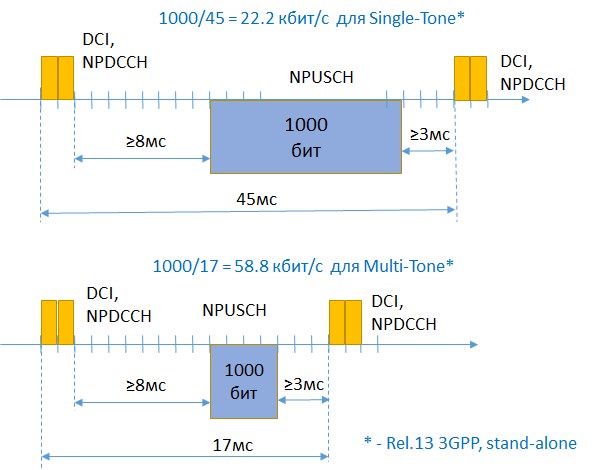
Fig.9. UL transfer rate.
Thus, the use of Dual-HARQ and the increased size of the transport blocks themselves up to 2536 bits (release 14 3GPP), allow increasing the transmission speed in DL and in UL above 100kbit / s.
That's all - if we talk about the main features in terms of radio access architecture, without going far to the side. Hopefully it was helpful. Soon - in the next post - we will tell you how the core network (Core Network) has changed with NB-IoT. We would appreciate feedback.
Author:
Expert of the MTS radio access network architecture department Ilnur Fauziev ilnurf

NB-IoT technology has inherited a lot from LTE - from the physical structure of the radio signal to the architecture. Everything cannot be listed in one article, so we will try to focus on the main features for the sake of which this technology was created. So:
')
What is the difference between NB-IoT in terms of the radio access network architecture?
First, remember the important thing about LTE:
For the LTE signal, the principle of separation of OFDM channels with a subcarrier spacing of 15 kHz is used. In DL (Downlink, direction from BS), OFDMA is used, and in UL (Uplink, direction to BS), SC-FDMA is used. The whole carrier in LTE is divided into resource blocks (Resource block, RB), each of which consists of 12 subcarriers and a total occupied bandwidth of 12x15 kHz = 180 kHz (Fig. 1). Each resource block is divided into 12x7 = 84 resource elements (Resource element, RE).

Fig.1. Resource block, Resource element
To achieve high cell throughput, high modulation orders of QAM256 are used for DL and QAM64 in UL. In addition, MIMO2x2 and MIMO4x4 technologies will be used for the same purpose.
Features of the radio signal NB-IoT :
The most important thing in the NB-IoT is the ability to work at lower signal levels and at high noise levels, as well as saving battery power. NB-IoT is also designed to transmit short messages, and it is not required to transfer audio-video content, large files and other things from it.
On this basis, on the physical level there are certain features that help provide the necessary characteristics:
- the total band for the NB-IoT is limited to one RB 180 kHz wide;
- the radio path of the user device has only one antenna, receiver and transmitter;
- transmission and reception are separated in time, i.e. this is essentially half duplex;
- the ability to transmit in the direction of UL on one subcarrier;
- modulation types used are limited to BPSK and QPSK;
- repeated enhancement of the transmitted signal (coverage enhancement).
Below we will focus on some of them in more detail.
The use of a narrow band of frequencies in one RB, one antenna and half-duplex transmission mode allows you to simplify the device and achieve:
- reduce the requirements for processor power;
- reduce energy consumption;
- size reduction;
- cheaper device.
Radio frequency assignment:
For the NB-IoT, almost all the same frequency bands as the 2G / 3G / 4G in the “low” band can be used. These are B20 (800 MHz), B8 (900 MHz), B3 (1800 MHz). There is no sense to use “higher” frequencies because of the greater attenuation of the signal.
There are three ways to allocate frequency resource for NB-IoT:
1. Stand-alone.
Dedicated frequency channel width of 200 kHz. This option is the most effective for the work of NB-IoT, but also the most costly. The fact is that in this case it may be necessary from 300 to 600 kHz of a very valuable spectrum, together with guard intervals. In this case, mutual interference with other technologies is minimal (Fig. 2).

Fig. 2. Options for placing NB-IoT in stand-alone mode.
2. In-band
In this case, resources are allocated for the NB-IoT within the existing LTE carrier, but the NB-IoT carrier has an increased power of 6 dB compared to LTE resource blocks. This option is well suited for saving frequency resource, but there is a problem of mutual influence with the LTE network (Fig. 3).

Fig. 3. Placing the NB-IoT in in-band mode.
3. Guard Band
In this case, the NB-IoT starts in the so-called guard interval. For example, in the LTE10MHz band, 500 kHz of free spectrum used as a guard interval. As in the in-band mode for longer range, the NB-IoT carrier has an increased power of 6-9 dB as compared to LTE resource blocks (Fig.4). This use case allows you to simultaneously save frequency resource and reduce mutual influence with the LTE network, although in this case, out-of-band emission parameters for LTE deteriorate.

Fig. 4. Placing the NB-IoT in guard-band mode.
The ability to transmit in the direction of UL on one subcarrier:
If in LTE, blocks of resource groups consisting of one or several RBs are allocated to a subscriber, then in NB-IoT the minimum unit is RE - portions of a radio resource are cut to the subscriber. Therefore, it became possible for the device to transmit a signal in UL on one subcarrier at 15 kHz. At the same time, now for the NB-IoT, the division of the RB into 48 subcarriers at 3.75 kHz in the UL direction has already been standardized. The duration of the resource elements at the same time is quadrupled, and, accordingly, the timeslot up to 2 ms, so their information capacity does not change (Fig. 5).

Fig.5. Resource element.
Signal transmission in a narrow band on one subcarrier of 15 kHz, and even more so at 3.75 kHz, can significantly increase the spectral density of the signal and, accordingly, the signal-to-noise ratio, which is very important for subscriber devices that have much less powerful transmitters than the base station. Moreover, in NB-IoT, as well as in LTE, the power of subscriber devices is limited to 23 dBm (200 mW).
At the same time, if the radio conditions allow, to reduce the time of the active transmission mode, and accordingly save the battery, it is possible to transmit on several subcarriers simultaneously. Transmission on one subcarrier has the name of the single-tone transmission mode, and on several - multi-tone (this is 3, 6 or 12 subcarriers at 15 kHz). Figure 6 shows the formation of different variations of the resource unit from the resource elements (Resource unit, RU).

Fig.6. Resource units (RU).
RU is the next larger brick from which transport blocks (Transport block, TB) are formed, which are assigned to the user. In one TB can be from one to ten RU. However, depending on the quality of the signal, each TB may contain a different amount of useful information depending on the modulation coding scheme (MCS) used. The TB size in the NB-IoT is, of course, much smaller than in LTE and is 680 bits in DL and 1000 bits in UL (Rel.13 3GPP). Also in this standard there is only one HARQ process (Hybrid Automatic Repeat Request), so the next TB can only be transmitted after acknowledging the reception of the previous TB. In release 14 of 3GPP, transport block sizes are increased to 2536 bits and Dual-HARQ, which allows two transport blocks to be transmitted in a row.
Coverage enhancement:
Another feature of NB-IoT is the coverage enhancement functionality, which is achieved by successive repetitions of the transmitted signal. This mechanism should not be confused with the re-transmission of a packet in case of unsuccessful reception; in the case of coverage enhancement, the decision on the success of the received signal occurs after receiving all repeated messages (Fig. 7). All physical channels NPDCCH, NPDSCH, NPRACH and NPUSCH (here N is the Narrowband prefix) can repeat.

Fig. 7. Repeats in NB-IoT
The standard defines three stages, called the coverage level 0, 1 and 2. The number of repetitions can vary widely and is set individually for each type of physical channel and its format. For example, the standard specifies values for a useful signal in UL up to 128 and in DL up to 2048. In reality, of course, everything will depend on the network settings optimized for operation (stand-alone, in-band / guard-band), signal quality and other conditions. Repeaters allow you to decode a signal at a much lower level of the signal-to-noise ratio theoretically up to 10 dB and below.
All of the above - the use of a narrower bandwidth and coverage enhancement function - allows you to eventually achieve the notorious gain of 20 dB relative to GSM.
Transmission rates in NB-IoT
In general, the principle of IoT itself, as already mentioned above, does not imply a significant exchange of information with devices, and accordingly, these values are very conditional. First, they are achieved only with good signal quality. Secondly, the signaling exchange, including the designation of the DCI kahal and the acknowledgment of ACK reception, is not adapted, as in LTE, to obtain maximum speeds. Thirdly, if the device transmits only one or two short messages, then in this case it is not entirely unambiguous what is meant by transmission speed. But not to say about the speed here is impossible. For example, Fig. 8 shows the calculated speed in DL for the user.

Fig.8. DL Transmission Rate
The figure shows that in NB-IoT, unlike LTE, the user device cannot occupy the entire available radio resource. And the rest of the BS radio resource can be used to communicate with other devices. The situation is similar in UL (Fig. 9).

Fig.9. UL transfer rate.
Thus, the use of Dual-HARQ and the increased size of the transport blocks themselves up to 2536 bits (release 14 3GPP), allow increasing the transmission speed in DL and in UL above 100kbit / s.
That's all - if we talk about the main features in terms of radio access architecture, without going far to the side. Hopefully it was helpful. Soon - in the next post - we will tell you how the core network (Core Network) has changed with NB-IoT. We would appreciate feedback.
Author:
Expert of the MTS radio access network architecture department Ilnur Fauziev ilnurf
Source: https://habr.com/ru/post/430496/
All Articles